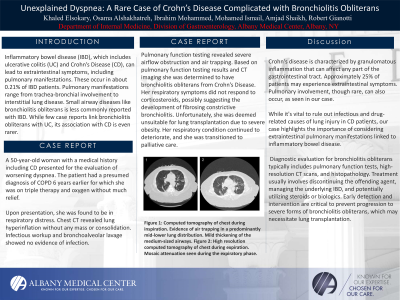Monday Poster Session
Category: IBD
P2699 - Unexplained Dyspnea: A Rare Case of Crohn’s Disease Complicated with Bronchiolitis Obliterans
Monday, October 28, 2024
10:30 AM - 4:00 PM ET
Location: Exhibit Hall E

Has Audio
- KE
Khaled Elsokary, DO
Albany Medical Center
Albany, NY
Presenting Author(s)
Khaled Elsokary, DO1, Osama Alshakhatreh, MD1, Ibrahim Mohammed, MD1, Mohamed Ismail, DO2, Amjad Shaikh, MD1, Robert Gianotti, MD1
1Albany Medical Center, Albany, NY; 2Rutgers New Jersey Medical School, Newark, NJ
Introduction: Inflammatory bowel disease (IBD), which includes ulcerative colitis (UC) and Crohn’s Disease (CD), can lead to extraintestinal symptoms, including pulmonary manifestations. These occur in about 0.21% of IBD patients. Pulmonary manifestations range from trachea-bronchial involvement to interstitial lung disease. Small airway diseases like bronchiolitis obliterans is less commonly reported with IBD. While few case reports link bronchiolitis obliterans with UC, its association with CD is even rarer.
Case Description/Methods: A 50-year-old woman with a medical history including CD presented for the evaluation of worsening dyspnea. The patient had a presumed diagnosis of COPD 6 years earlier for which she was on triple therapy and oxygen without much relief.
Upon presentation, she was found to be in respiratory distress. Chest CT revealed lung hyperinflation without any mass or consolidation. Infectious workup and bronchoalveolar lavage showed no evidence of infection. Pulmonary function testing revealed severe airflow obstruction and air trapping. Based on pulmonary function testing results and CT imaging she was determined to have bronchiolitis obliterans from Crohn’s Disease. Her respiratory symptoms did not respond to corticosteroids, possibly suggesting the development of fibrosing constrictive bronchiolitis. Unfortunately, she was deemed unsuitable for lung transplantation due to severe obesity. Her respiratory condition continued to deteriorate, and she was transitioned to palliative care.
Discussion: Crohn's disease is characterized by granulomatous inflammation that can affect any part of the gastrointestinal tract. Approximately 25% of patients may experience extraintestinal symptoms. Pulmonary involvement, though rare, can also occur, as seen in our case. While it's vital to rule out infectious and drug-related causes of lung injury in CD patients, our case highlights the importance of considering extraintestinal pulmonary manifestations linked to inflammatory bowel disease. Diagnostic evaluation for bronchiolitis obliterans typically includes pulmonary function tests, high-resolution CT scans, and histopathology. Treatment usually involves discontinuing the offending agent, managing the underlying IBD, and potentially utilizing steroids or biologics. Early detection and intervention are critical to prevent progression to severe forms of bronchiolitis obliterans, which may necessitate lung transplantation.

Disclosures:
Khaled Elsokary, DO1, Osama Alshakhatreh, MD1, Ibrahim Mohammed, MD1, Mohamed Ismail, DO2, Amjad Shaikh, MD1, Robert Gianotti, MD1. P2699 - Unexplained Dyspnea: A Rare Case of Crohn’s Disease Complicated with Bronchiolitis Obliterans, ACG 2024 Annual Scientific Meeting Abstracts. Philadelphia, PA: American College of Gastroenterology.
1Albany Medical Center, Albany, NY; 2Rutgers New Jersey Medical School, Newark, NJ
Introduction: Inflammatory bowel disease (IBD), which includes ulcerative colitis (UC) and Crohn’s Disease (CD), can lead to extraintestinal symptoms, including pulmonary manifestations. These occur in about 0.21% of IBD patients. Pulmonary manifestations range from trachea-bronchial involvement to interstitial lung disease. Small airway diseases like bronchiolitis obliterans is less commonly reported with IBD. While few case reports link bronchiolitis obliterans with UC, its association with CD is even rarer.
Case Description/Methods: A 50-year-old woman with a medical history including CD presented for the evaluation of worsening dyspnea. The patient had a presumed diagnosis of COPD 6 years earlier for which she was on triple therapy and oxygen without much relief.
Upon presentation, she was found to be in respiratory distress. Chest CT revealed lung hyperinflation without any mass or consolidation. Infectious workup and bronchoalveolar lavage showed no evidence of infection. Pulmonary function testing revealed severe airflow obstruction and air trapping. Based on pulmonary function testing results and CT imaging she was determined to have bronchiolitis obliterans from Crohn’s Disease. Her respiratory symptoms did not respond to corticosteroids, possibly suggesting the development of fibrosing constrictive bronchiolitis. Unfortunately, she was deemed unsuitable for lung transplantation due to severe obesity. Her respiratory condition continued to deteriorate, and she was transitioned to palliative care.
Discussion: Crohn's disease is characterized by granulomatous inflammation that can affect any part of the gastrointestinal tract. Approximately 25% of patients may experience extraintestinal symptoms. Pulmonary involvement, though rare, can also occur, as seen in our case. While it's vital to rule out infectious and drug-related causes of lung injury in CD patients, our case highlights the importance of considering extraintestinal pulmonary manifestations linked to inflammatory bowel disease. Diagnostic evaluation for bronchiolitis obliterans typically includes pulmonary function tests, high-resolution CT scans, and histopathology. Treatment usually involves discontinuing the offending agent, managing the underlying IBD, and potentially utilizing steroids or biologics. Early detection and intervention are critical to prevent progression to severe forms of bronchiolitis obliterans, which may necessitate lung transplantation.

Figure: Figure 1: High resolution computed tomography of chest during inspiration. Evidence of air trapping in a predominantly mid-lower lung distribution. Mild thickening of the medium-sized airways.
Figure 2: High resolution computed tomography of chest during expiration. Moasic attenuation seen during the expiratory phase.
Figure 2: High resolution computed tomography of chest during expiration. Moasic attenuation seen during the expiratory phase.
Disclosures:
Khaled Elsokary indicated no relevant financial relationships.
Osama Alshakhatreh indicated no relevant financial relationships.
Ibrahim Mohammed indicated no relevant financial relationships.
Mohamed Ismail indicated no relevant financial relationships.
Amjad Shaikh indicated no relevant financial relationships.
Robert Gianotti indicated no relevant financial relationships.
Khaled Elsokary, DO1, Osama Alshakhatreh, MD1, Ibrahim Mohammed, MD1, Mohamed Ismail, DO2, Amjad Shaikh, MD1, Robert Gianotti, MD1. P2699 - Unexplained Dyspnea: A Rare Case of Crohn’s Disease Complicated with Bronchiolitis Obliterans, ACG 2024 Annual Scientific Meeting Abstracts. Philadelphia, PA: American College of Gastroenterology.
